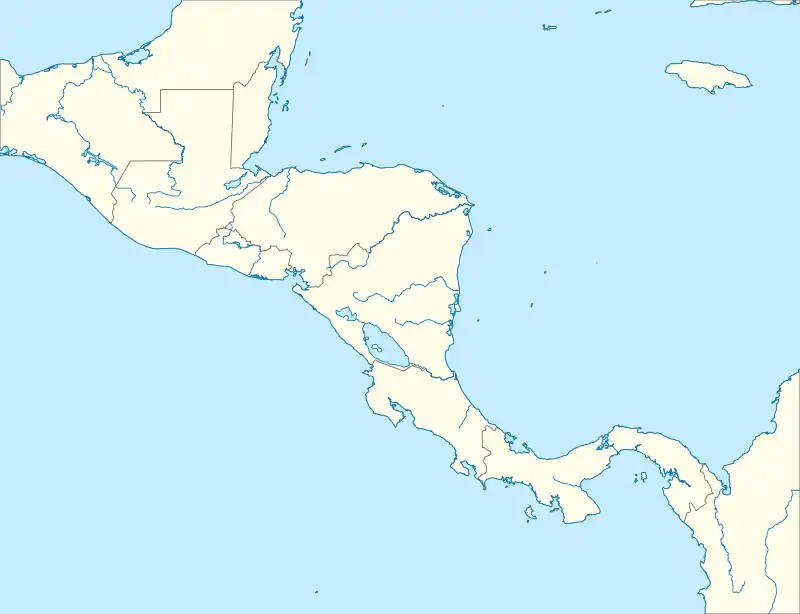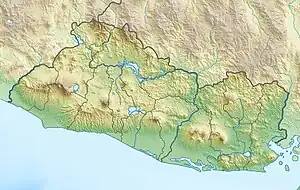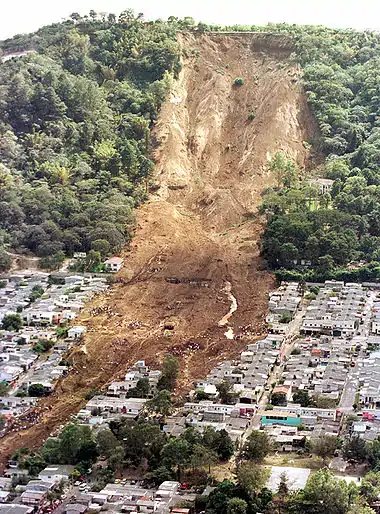January 2001 El Salvador earthquake
The January 2001 El Salvador earthquake struck El Salvador on January 13, 2001, at 17:33:34 UTC. The 7.6 (later estimated to be 7.7 or 7.9)[1] quake struck with the epicenter 60 miles (100 km) SW of San Miguel, El Salvador (13.04°N 88.66°W) at a depth of 60 km.
  | |
| UTC time | 2001-01-13 17:33:32 |
|---|---|
| ISC event | 1763440 |
| USGS-ANSS | ComCat |
| Local date | January 13, 2001 |
| Local time | 11:33 |
| Magnitude | 7.7-7.9 Mw[1] |
| Depth | 60 kilometres (37 mi)[2][3] |
| Epicenter | 13.04°N 88.66°W |
| Type | Normal |
| Areas affected | El Salvador Guatemala |
| Max. intensity | VIII (Severe) |
| Casualties |
|
Impact

At least 944 people were killed, 5,565 others were injured, 108,261 houses collapsed, with another 169,692 houses damaged, and more than 150,000 buildings were damaged in El Salvador.[4][5] About 585 of the deaths were caused by large landslides in Santa Tecla and Comasagua. As is often the case after earthquakes in El Salvador, landslides wreaked significant damage. Estimation of the number of slides is difficult because individual scarps conjoin. The total has been reported as high as 16,000, though it is unclear how this figure was arrived at.[6] Damage and injuries occurred in every department of El Salvador, particularly the departments of La Libertad and Usulután. Eight people were killed in Guatemala. The tremor was felt from Mexico City to Colombia.[2] An aftershock measuring 5.7 magnitude was felt on January 15, an event not widely reported outside the country until after another earthquake on February 13, which initially was assessed by the USGS at 5.7 magnitude as well.[7]
As of February 2, 2001, more than 2,500 aftershocks had hit El Salvador, leading to additional damage and terrorizing the inhabitants. Clean water and sanitation became a matter of grave concern in many areas due to the earthquake's destruction of some $7 million to municipal drinking water systems, and tens of thousands of people were living outdoors in spite of the approaching rainy season (Invierno).[8] Government and public health organizations warned of the possible spread of disease as desperate people began to scavenge debris piles – some containing severed human limbs – looking for items they could pawn to purchase needed food and other commodities.[9]
Tectonic setting
El Salvador lies above the convergent boundary where oceanic crust of the Cocos Plate is being subducted beneath the Caribbean Plate at rate of about 72 mm per year along the Middle America Trench. This boundary is associated with earthquakes resulting from movement on the plate interface itself, such as the Mw 7.7 1992 Nicaragua earthquake, and from faulting within both the overriding Caribbean Plate and the subducting Cocos Plate, such as the 1982 El Salvador earthquake.[10][11]
Earthquake
The January 13 earthquake was a result of normal faulting within the subducting Cocos Plate as shown by the hypocentral depth and published focal mechanisms. Of the two possible fault planes indicated, analysis of observed seismic waves supports the solution with a fault plane dipping moderately to the northeast.[10][11] It was followed by a series of aftershocks, including 70 greater than M 4 of which 10 were greater than M 5 in the period up to February 2, 2020. The largest aftershock was an M 5.8 event at 12:20 on January 15.[12]
Exactly one month after the mainshock there was another destructive earthquake, which occurred on an entirely different fault within the overriding Caribbean Plate, leading to a further 315 deaths.[11]
Post-quake analysis
In the days and weeks following the earthquakes, Salvadoran and foreign agencies analysed the factors that had facilitated the destruction the disasters had caused. While Salvadoran government representatives were quick to point out that the destruction had been far less than that of the 1986 earthquakes,[13] outside researchers critiqued shortcomings in preparedness and in policies toward land development that had permitted massive deforestation in the Santa Tecla area. Mexican seismologists invited by the Salvadoran government summarized their observations this way:
The construction equipment of the Ministry of Public Works was thinly stretched over hundreds of earth slumps and seemed inadequate to the task. ... The many homeless were not much in evidence; in the countryside they had been housed in temporary huts under the supervision of the armed forces, or with relatives. No homeless people were seen in the streets of San Salvador, presumably because the middle class had sustained the brunt of the damage. There was a palpable desire in the capital to forget the earthquake drama as quickly as possible.
This may be the wrong time to forget. ...According to some press reports, the developers at Las Colinas had been authorized to proceed in spite of existing zoning regulations designed to prevent residential developments on the slopes. The location was a desirable one because the Santa Tecla area was relatively safe from guerrilla operations. After pacification the pressure from developers subsided as there seems to be plenty of available land in the valley; but there is a definite need for setting up enforceable zoning regulations in order to protect the hillsides from future deforestation and encroachment by developers. ...
The 2001 earthquake did not approach the level of severity of some previous earthquakes, yet it wiped out the equivalent of half the annual gross national income. A small investment in preparedness would pay off handsomely.
— Cinna Lomnitz and Sergio Rodríguez Elizararrás[14]
The government's response to the earthquakes was critiqued from different sides, with some criticizing the legislature for not approving the full amount of emergency funding urged by President Flores,[9] and others condemning what they saw as the ARENA government's contributions to the devastation. The Nicaragua-based magazine Envío argued that the conservative government's pro-business stance had fostered aggressive levels of land development, coupled with high poverty rates that forced poor rural residents to make do with inadequate but cheap building materials, asserting: "Totaling up these factors makes it clear that the consequences of a natural phenomenon like an earthquake cannot be described as 'natural' ... Describing the January 13 earthquake as a 'natural disaster' is not only irresponsible, but also a declaration of future impotence. It assumes fatalistic acceptance that no natural phenomena can be prevented and that all one can do is respond to emergencies as they arise and try to rehabilitate and reconstruct what has been destroyed." The magazine further critiqued the government's optimism about economic recovery in the aftermath of the first quake as an "insulting" minimization of the tragedy caused across the country and as an attempt to shore up the dollarization campaign that had been the focus of political attention up until the quakes.[15]
See also
References
- Later estimates were revised to 7.7 or 7.9; see USGS Preliminary Earthquake Report Archived 2004-06-03 at the Wayback Machine and American Red Cross Archived 2007-08-14 at the Wayback Machine, for example.
- United States Geological Survey, National Earthquake Information Center. "Magnitude 7.7 EL SALVADOR 2001 January 13 17:33:32 UTC Preliminary Earthquake Report". Archived from the original on June 3, 2004. Retrieved January 13, 2020.
- National Aeronautics and Space Administration. "Science Question of the Week" Archived 2008-05-11 at the Wayback Machine (comparing January 2001 quakes in India and El Salvador), NASA.gov, February 8, 2001. NASA estimates the epicenter depth at 39 km.
- "Consolidado Final de Afectaciones - Terremoto El Salvador 13 de Enero de 2001" (PDF) (in Spanish). Archived from the original (PDF) on September 24, 2015.
- Government of El Salvador. "A 14 años del terremoto del 13 de enero de 2001". ReliefWeb (in Spanish). Retrieved January 13, 2020.
- Le Val Lund and Carl Sepponen, ed. (2002). Lifeline Performance of El Salvador Earthquakes of January 13 and February 13, 2001. Reston, VA: ASCE, TCLEE. ISBN 9780784406625. Archived from the original on 2013-01-12.
- CNN. "Quake aftershock frightens Salvadorans," CNN.com, February 13, 2001.
- Christian Aid. "El Salvador Earthquake: Emergency Update 02 Feb 2001" (press release), on ReliefWeb.int, February 2, 2001.
- CNN. "Poor sanitation fuels disease fears in aftermath of Salvador quake," CNN.com, January 20, 2001.
- ANSS. "El Salvador 2001: M 7.7 – offshore El Salvador". Comprehensive Catalog. U.S. Geological Survey. Retrieved April 4, 2020.
- Bommer, J. J.; Benito, M. B.; Ciudad-Real, M.; Lemoine, A.; López-Menjívar, M. A.; Madariaga, R.; Mankelow, J.; Méndez De Hasbun, P.; Murphy, W.; Nieto-Lovo, M.; Rodríguez-Pineda, C. E.; Rosa, H. (2002), "The El Salvador earthquakes of January and February 2001: Context, characteristics and implications for seismic risk" (PDF), Soil Dynamics and Earthquake Engineering, 22 (5): 389–418, doi:10.1016/S0267-7261(02)00024-6, archived from the original (PDF) on 2011-10-08
- ANSS. "Search results". Retrieved April 6, 2020.
- Ambassador Rene Leon, interviewed by Ray Suarez. "Salvadoran Earthquake," OnlineNewsHour, January 15, 2001.
- Cinna Lomnitz and Sergio Rodríguez Elizararrás, Universidad Nacional Autónoma de México. "El Salvador 2001: Earthquake disaster and disaster preparedness in a tropical volcanic environment," paper submitted to Seismological Research Letters.
- Ismael Moreno. "Dollarization and the Earthquake: Two Manmade Disasters," Revista Envío, January 2001.
External links
- First quake (USGS)
- Second quake (USGS)
- Images – International Services – El Salvador Earthquake, 2001, photos and information by the American Red Cross
- The International Seismological Centre has a bibliography and/or authoritative data for this event.
- ReliefWeb's main page for this event.
![]() This article incorporates public domain material from websites or documents of the United States Geological Survey.
This article incorporates public domain material from websites or documents of the United States Geological Survey.